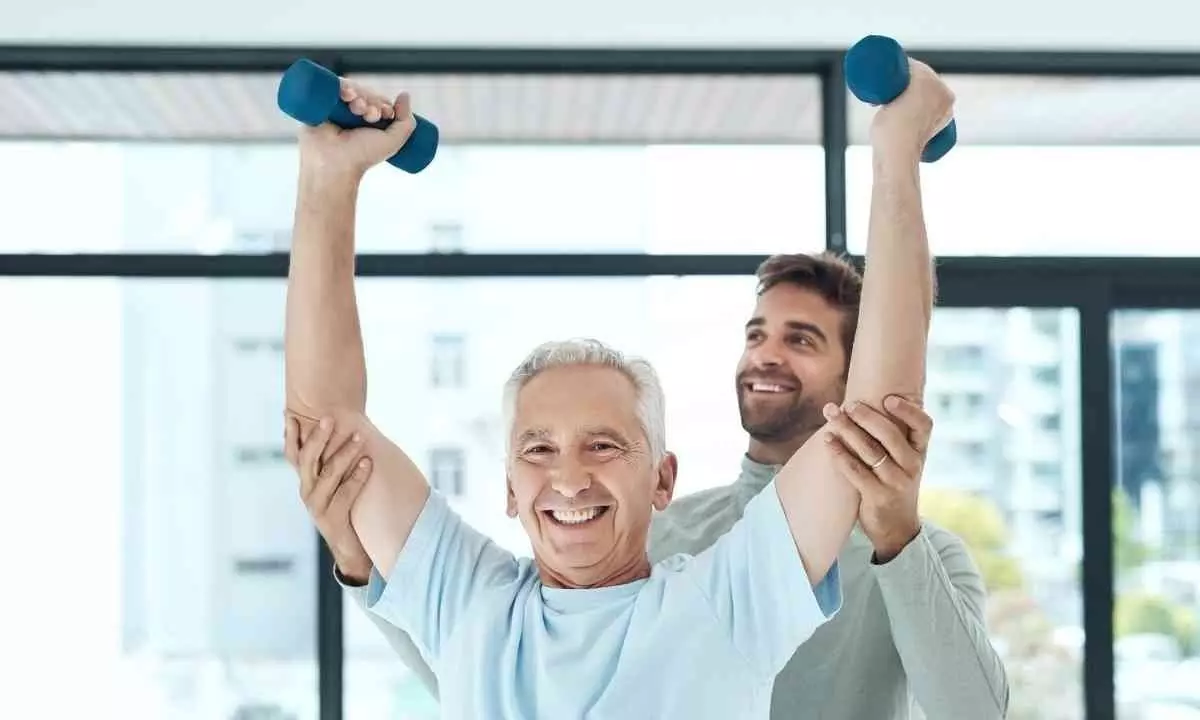Live
- Anakapalli zone in focus for development
- 28 youths given compationate appointments in Singareni
- First batch in TASK Centre from November 4: Collector
- Spectacular Drone Light Show thrills viewers
- Asst Prof Hari Krishna in MLC poll fray
- TTD JEO inspects children’s hospital works in Tirupati
- HM Amit Shah’s birthday: BJP activists organise food distribution
- Second edition of Japan Month at IITH wraps up successfully
- HYDRA lens on city lakes, takes up cleanup process
- City techie appointed as VC of Cong Data & Tech Dept
Just In
Role of physiotherapy in geriatric people physiotherapist for elderly care


Role of physiotherapy in geriatric people physiotherapist for elderly care
Ageing or getting old makes our body go through many physical changes.
Ageing or getting old makes our body go through many physical changes. These changes usually cause a decrease in muscle strength, making the joints stiffer, sometimes leading to falls and fractures. However, for elderly citizens, exercising may be the key to returning to living. Physiotherapists are trained professionals who can identify the factors that prevent the elderly from being active and help to reduce the risk and impact of illness.
Conditions treated by Geriatric Physiotherapists
Geriatric conditions are susceptible to various musculoskeletal, neurological and cardiopulmonary problems
1. Pain from chronic conditions
Physiotherapy can help to decrease discomfort due to conditions like arthritis or osteoporosis.
2 improve strength and flexibility
Due to ageing, decreased strength and flexibility are one of the most common issues almost everyone faces.
A physiotherapist helps to alleviate pain and help return to mobility; some common causes are depression, lack of sleep, diabetes, congestive heart failure, and medication side effects. Physiotherapy helps to bring back strength in life.
3. Postural Instability
Balance impairment in older people is due to the loss of normal functioning of muscles and bones. Physiotherapy treatment includes balance exercises to help individuals having neurological conditions such as Alzheimer's disease, ALS, Parkinson's disease, or who suffered brain injury.
4. Prevention of risk of a fall
Falls are the leading cause of accidents among aged individuals resulting in bone fractures and other injuries.
Medical history
Medical history Obtaining a thorough medical/surgical history and supporting drug history is important in particular medications that can significantly impact the older adult and contribute to poor mobility and falls.
Social history
Social History, Vital older adults often rely on formal or informal support (family and friends).
Physiotherapy treatments
Physiotherapy includes exercises, workouts, and using electric modalities such as Ultrasound, TEN, and Shock wave therapy, moderate-intensity activity like brisk walking is recommended. In addition, strengthening exercises for muscles can be done against resistance by using stretchy bands!
Goals
Goals are essential for keeping therapy person-centred and co-ordinating treatments, Goals should be directed towards managing and improving a condition rather than passive care towards an older person.
Chest physiotherapy for ICU patients
The respiratory system consists of the airways, lungs as well as musculoskeletal structures of the thoracic cage. Respiration involves a gas exchange between the atmosphere and the lungs, lungs and blood, and body tissues. The function of this system is to maintain the supply of oxygen and the removal of carbon dioxide from the body. Failure in any of the respiratory system components can result in the need for mechanical ventilation.
Respiratory dysfunction is a common problem associated with the critically ill in Intensive Care Unit (ICU); critically ill patients in ICU are often confined to their beds, resulting in general deconditioning impacting many body systems, including the respiratory system. Therefore, pulmonary complications, the leading cause of hospital morbidity, are of great concern in ICU patients. Common complications following bed rest include reduced lung volumes and expiratory airflow rate, decreased respiratory muscle strength, reduced lung and chest wall compliance, and impaired gas exchange. These factors all lead to an increase in the patient's work of breathing and the risk of developing pneumonia and atelectasis. The respiratory muscles' weakness and the reduction in tidal volume can impair the cough mechanism, further increasing the risk of pulmonary.
Aims of Physiotherapy for Pulmonary diseases
1. Airway secretion clearance
2. Recruitment of lung volume or improvement of atelectasis
3.Maintenance/improvement of oxygenation
4.Maintenance/improvement of inspiratory muscle strength
Physiotherapy Modalities for Respiratory Care
• Modalities for Airway Clearance
• Positioning (Postural Drainage)
• Manual chest techniques (Percussion. Vibration, and Shaking)
• Airway Suctioning (open/close
• Nebulisation
• Assisted Cough Techniques
• Forced expiratory maneuver (Coughing/Huffin
(The doctor is B. PT MIAP, in Care Physiotherapy Clinic, Opp Andhra Bank, HMT Nagar, Nacharam, Hyderabad Ph: 9550687151 9849722091)

© 2024 Hyderabad Media House Limited/The Hans India. All rights reserved. Powered by hocalwire.com






